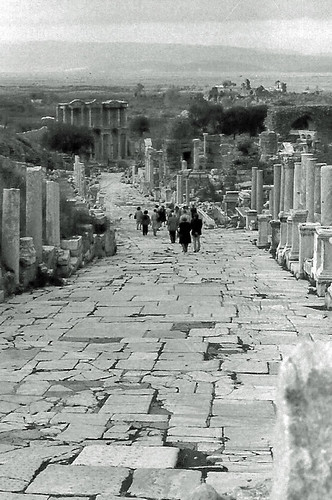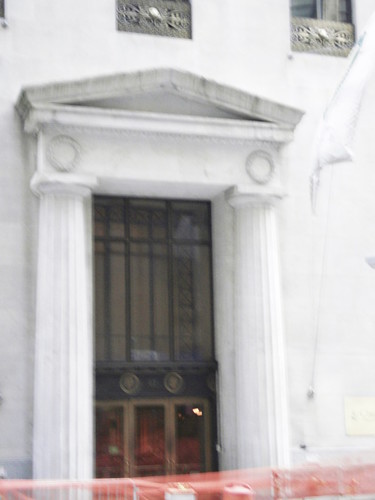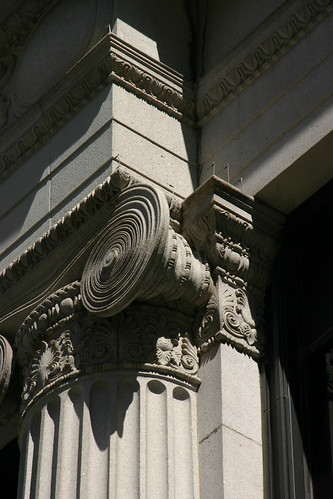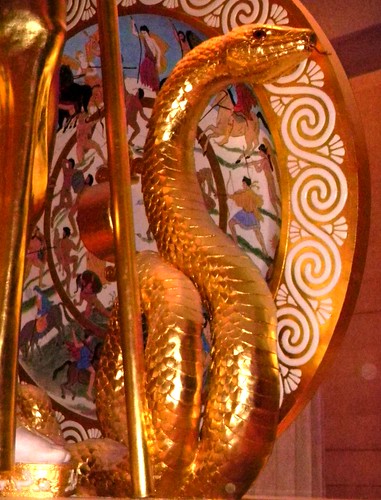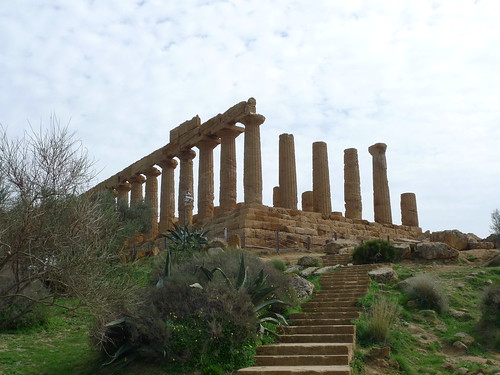
Image : http://www.flickr.com
"But what about the Greeks? Their national character is based on the idea of the impoverished and downtrodden little man getting the better of the world around him by sheer cunning." - Lawrence Durrell, Prospero's Cell (1945)
The Greek crisis has exposed existential weaknesses in the Greek economy and revealed shortcomings in the larger European system of financial checks and balances. But the often emotional responses have also proven a cultural polarity between north and south. The German magazine, Focus, captured this antagonism by an image of the Venus of Milo suggestively sticking up the middle finger at Germany. Angered Greeks in return reminded Germans of the Nazi looting of Greek gold reserves and unpaid war retributions.
Beyond this populism in the media, there exists a fundamental rift in policy views between Mediterranean countries on the one side and Atlantic countries on the other side. In his influential book, The Protestant Ethic and the Spirit of Capitalism (1905), the German sociologist Max Weber studied already the relationship between culture and economic performance. Weber considered the Protestant working ethic a pivotal element in the development of capitalist modernity. Behind the state of affairs of the Greek crisis lie causes rooted deeper in Greek culture than the immediate problems of government and economic structure. The traces of these historic roots carve an individual psychology and shape social norms that are difficult to change with measures of policy by politicians responding to the market's wits.
In traditional Greek dances a group of dancers, interlocked arm over shoulder, form a circle and move with a set of prescribed steps. The Greeks do not easily break with their tradition and they do not possess an innate curiosity for the new like Western culture. Greeks depend on the bonds with family and their community. Arms locked, only the leader of the dance improvises, while the rest do not break the line of the circle.
The eyes of the international financial markets are on the fiscal measures announced by George Papandreou, the first citizen of Athens, and the reforms to be implemented by the central government. The response of Greek society and the economic support by the European Union members will be decisive in their success. The question is if the government can enforce the new policies in a country so geographically scattered and with a history of tax evasion as Greece. Historically Greeks dislike central government and have relied primarily on local self-governance, strengthened by the geographic distance of the islands from Athens and the isolation of mountainous villages. Not even the chief-god Zeus could rule the lesser Greek gods from the peaks of Mount Olympus, the highest mountain in the country. Greek history justifies mistrust in a Greek success. Measures to centralize government and constitute an efficient modern state have always been resisted, from classic times with the Delian League that ended in the Peloponnesian War, the occupation by the Ottoman Empire that gave birth to the palikare, the Greek folk hero, or the rise of the current government for which corruption and tax evasion are emblematic.
When the Persian empire threatened the independence of the Greek city states, Athens and the allied Greek city states formed the Delian League in 487 BCE. Members of the League were obliged to contribute soldiers for the defense of Greek democracies or could alternatively pay taxes to the League. When Athens started to control the League, Athens forced other city states to continue paying taxes to the League solely for its own benefit. When cities refused, they faced the wrath of the Athenian army and were simply annexed by Athens. But when the famous statesman Pericles moved the treasury holding the paid tax contributions, from the island of Delos to Athens, the rest of the Greeks defied. The resistance against dominance by Athens resulted in the Peloponnesian Wars and finally in the defeat and surrender of Athens in 404 BCE. Can Athens ensure a different outcome now?
Already under the Ottoman empire the Greeks resisted taxation, which was a symbol of oppression. From the fifteenth century they suffered heavy taxation by the Ottomans. As Christians under Islamic rule they were obliged to pay a land tax and the jizya, a tax for non-Muslims which was symbolic for subjection to the Ottoman rule. Heavy taxation reduced most Greeks to subsistence farming, while large estates fell into the hands of Ottoman nobles. Resentment against such taxation accumulated over almost five hundred years of occupation. The problems of modern Greece cannot be understood without understanding this Ottoman occupation of Greece and the long struggle for independence that lasted over a century, only ending bitterly for the Greeks in the disastrous defeat of 1922 against the forces of Atatürk's modern Turkish state. The 1922 defeat meant an end to the Greek megali idea or great idea of a larger Greece that included Asia Minor and Constantinople, current day Istanbul. This defeat of the Greek state in Asia Minor was a failure by the central state with traumatic consequences.
The Museum for the Macedonian Struggle in Thessaloniki is a very small museum but with a deeply significant meaning for Greeks. In a corner mansion behind Aristotle Square, it showcases the history of the Macedonian Struggle, the guerrilla war against the Ottomans from 1900 to 1908, which annexed the Greek populace in Macedonia to the independent Greek territory. In 1821 the Greeks had won independence but it did not extend far beyond the Peloponnesos and Attica. The annexation of Macedonia gave the Greek state a renewed confidence that defined the Greek national identity and placed a claim on all territory in the greater region with Greek populations.
One room in the museum is devoted to Pavlos Melas who fought in the Macedonian Struggle. Behind a vitrine lay on view relics of Melas and part of his former personal belongings, a Smith and Wesson 38 revolver, an invitation card to his wedding, ribbons from his memorial wreaths, and a tin cup. He is a national symbol for the enosi or union of Greece that was hard fought and thereby of the Greek national identity. He is the embodiment of the traditional Greek folk hero, the palikare. As a lieutenant he left the regular service in the new army of the Greek state in order to fight as a brigand or irregular fighter against Ottoman occupation in Northern Greece. Greece was confined largely to the Peloponnese and consisted of a patchwork of people with different dialects. The irregular fighters became folk heroes to the Greeks, where the regular Greek army seemed incapable to protect the occupied Greeks in the north.
The irregular fighters fought in the same tradition as the Greek Klepths. These men had fled to the mountains in the eighteenth century to avoid the rule of the Ottomans and had formed bands of outlaws that later fought in the Greek War of Independence from 1821 to 1829. But also the Ottomans had used irregular forces to control impenetrable mountain areas. They allowed powerful local captains in these lawless areas to rule at will under oversight of distant Ottoman overlords. Even in our time, the use of irregular fighters was widespread during the recent Balkan Wars.
The palikare was in essence not more than a small brigand, who in groups roamed the mountains under the banner of irredentism and liberation of the Greeks. They evaded the rule of law and depended often on captains that exercised local power. The Greek national writer, Nikos Kazantzakis, describes this archetype colorful in his novels. In Freedom and Death the palikare Captain Michales refuses to swallow the occupation of Crete by the Turks, and the unruly Zorba is described in the novel Zorba the Greek, brilliantly enacted by Anthony Quinn in the 1964 film. The mountain freedom fighter, evading authority and growing a beard in defiance, this is the Greek traditional spirit.
The palikare is a symbol of the current Greek financial crisis, reflected in a popular sentiment that rejects the centralized modern state and commends the outlaw. The Greeks do not identify with the politics of central government, despite the fact that one out of every four Greeks is a public servant and is directly dependent on the government for their income. The central government is considered wasteful and corrupt, from which it is justified to extort money. While the citizen rejects subjection to the rule of the central state, the central state is a corrupt body that accommodates a game of lies in order to accumulate monetary gain.
The Greeks cunningly receive an income from government, while evading taxes and participating in the informal economy, defrauding the central state. This lack of loyalty extends to the even more remote European Union. Greeks gladly accept the EU subsidies paying lip services to its demands, but resent any interference in their lives. This practice goes back to the times of the Ottoman state, where Greek subjects evaded being taxed but sent representatives to Constantinople to request fiscal favors. While Ottoman rule had instituted local self-governance as the means for tax-assessment and tax-collection, the system developed local councils that were dominated by powerful local captains and wealthy families with a patron-client dependence.
Since its independence in 1821 the modern Greek state that emerged out of the Ottoman system has not been able to eradicate this local patron-client system which depends on counter dealings and favoritism. On the contrary, it could only emerge and survive by favoring such interests of the powerful local patrons or captains in return for their support, in a similar process as the centralized power of the European Union only is advanced by returning political favors.
Prime-minister George Papandreou understands the Atlantic European perspective and sensitivities. Like many Greeks who worked in Germany or America for the best part of their lives, he lived and studied in America and in Sweden during the formative years in his life. But although George Papandreou calms European suspicions by vocalizing a firm though nothing but verbal promise of reform, he himself is a vested representative of those powerful families that are symbolic of the centuries-old formalized corruption. Papandreou's grandfather was three times prime-minister of Greece, his father founded the social-democratic party PASOK and also served as prime-minister, while the Nea Democratia party has been dominated by the patrons of the Karamanlis family.
Greek promises and measures of reform have pacified international markets and appeased European political leaders for the time being. Since Greece's accession to the EU, however, Greek promises and assurances have been provided continuously under very similar scandals, and there has been little assurance from recent developments in Greece that this time will be different. The cotton-growers of Thessaly are perhaps exemplary for the problems of the Greek economy which is simply not compatible on the international market and for Greek fraud. Cotton growers depend heavily on subsidies for profitability, not shunning fraud and corruption, like wetting the cotton crop with water to increase the weight of the cotton. In 1992, for instance Greek farmers invented one fifth of its cotton crop in order to claim extra EU subsidies, and in Greece cotton farmers recently blocked most of the highways in Northern Greece, demanding payments from the government to offset loss of income from falling cotton prices on the international markets, while having resisted agricultural reforms for decades.
And even while prime-minister George Papandreou was on a credibility-building tour around European capitals, among other speaking at the World Economic Forum in Davos to calm unrest on the financial markets and restore political credibility, his own Minister of Agriculture Katerina Batzeli reached an agreement with protesting farmers to provide financial compensation. Among the key measures was the injection of five and a half billion Euro by the Greek state to boost incomes and liquidity, promising little change in policies at home. And ask a Greek for an analysis of the current crisis, they will without exception point at the corruption of remote politicians, only admitting to some blame themselves in a delayed sub-clause.
But Europe has always been blinded by its love for Greece and one must fear that this will not change overnight. It has always admired Greece as the ideological and cultural foundation of European values. We learn from Greece the principles of Athenian democracy and copy Greek architecture, our secular thinkers study Heraclitus and Parmenides, our Christian moralists study Aristotle, Plato and Socrates, we learn the mathematics of Pythagoras, Euclid and Archimedes, our intellectuals learn by heart the Iliad and the Odyssey, even European cynics and stoics cling to the Greek. But this impression of Greece is overly romantic and Byronic, and one must hope that it is soon replaced by a more northern sense for Real-Politics.
The Philhellenic idea of a pastoral Greece in perfect harmony with nature disputes the complex reality of a twenty first century Greece. The sentiment of betrayal felt in Europe is as much a self-betrayal by a European Byronic complex. As Greece struggles to reconcile Western austerity with its Orthodox Byzantine generosity.
So, the Greek suitors have feasted and the time for reckoning has come. The return of order must be considered without sentimental attachments or unreasonable demands, while Europe must not be blinded by Greek cunning and abuse. The Greeks must decide to either be part of Europe and respect its fiscal rules or return to the Drachma as a political currency and loose its place at the European table.
"I detest that man, who hides one thing in the depths of his heart, and speaks forth another." - Homer, Iliad IX, 312-13
Remko Caprio
Living on Ikaria, Greece
Writing currently on several publications, among other, a Poetic Travel Guide 'The Lydian Verses' and a non-fiction publication 'The Ikarians' about the 'Red Island' better known as Ikaria, Greece.
Homepage: http://carackus.blogspot.com
Email: rc@remkocaprio.com
Remko Caprio is a European writer residing in New York City. He is currently at work on a travel guide of poetry called 'The Lydian Verses' describing ancient Lydia in Western Turkey. Influences: Fernando Pessoa, Henry Miller, Friedrich Nietzsche, Sigmund Freud, Karl Marx, Classicism, Surrealism, Nihislim, et al. You can find notes and writing in progress at his website http://carackus.blogspot.com.

